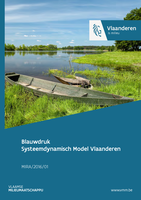Blueprint for a System Dynamics Model
For the preparation of the so-called blueprint various workshops were organised where experts and stakeholders could formulate proposals for improvement of the model.
What are system dynamics models?
System Dynamics Modelling originates in the World Model, which was developed for the Club of Rome in the late 1960s. System dynamics models are very useful for supporting long-term prospective studies and policy analyses. The purpose is to identify the "tipping points" which cause the system to change its behaviour significantly, for example from an equilibrium to a non-equilibrium state, rather than obtaining an accurate and very detailed prognosis of a system's behaviour. At the same time, a system dynamics model provides a practical analytical framework to support the integration between relevant themes such as mobility, energy, demography, environment, agriculture, etc. and the available (computational) models. Where more depth and detail are required, the causal relationships within the system can be described by means of thematic models.
System dynamics modelling and the 4-step plan for prospective studies
System dynamics modelling occupies a central place in the so-called 4-step plan for supporting prospective studies for Flemish environmental policy:
- Step 1: A qualitative system analysis to identify the relevant themes, issues and causes, actors, etc. and to relate these to one another at the main level of analysis, and to formulate story lines for the different world views.
- Step 2: Quantitative system dynamics modelling to fully extrapolate the story lines at the main level of analysis.
- Step 3: Thematic deepening by modelling for those components of the system dynamics model resulting from Step 2 that require greater detail.
- Step 4: Assessment of existing and planned policy measures against the policy objectives by means of the models resulting from Steps 2 and 3.
In August 2013, VITO completed the 'Feasibility study for system dynamics modelling and interaction with thematic modelling' (Dutch report with English summary) commissioned by MIRA. The purpose of this study was to explore the possibilities for developing a system dynamics model for Flanders. In addition to identifying the technical possibilities, step 1 of the 4-step plan was implemented.
In January 2015, the follow-up project 'Blueprint for System Dynamics Model for Flanders' was launched. This study belongs to step 1 and step 2 of the above-described 4-step plan. The qualitative system was further refined and the quantitative section implemented.
A blueprint
The blueprint "System Dynamics Model for Flanders" describes the feedback mechanisms between state variables at the main level of analysis for the following 10 themes: demography, economy, mobility, energy, land use, agriculture & food, water, air, nature & environment, and waste& materials. As a time horizon for the model the year 2050 is used, with a time step of one year and a typical simulation time of a few seconds.
The blueprint includes the following exogenous variables that affect the system at different points: technology & innovation, sustainable behaviour & policy, level of education, global fuel price, migration policy, household size, lifetime of capital, capacity of the main road network, and climate change. These variables can be set globally or individually to extrapolate certain scenarios. This results in a value for the year 2050 for a number of indicators such as GDP/capita, total population, Mtonne CO2, health index, etc.
For the purposes of illustration, the report extrapolates the four so-called Dutch WLO world views (welfare and environment) to Flanders: global economy (1), strong Europe (2), transatlantic market (3) and regional communities (4). The result of these four scenarios can be compared with the business-as-usual scenario for each indicator.
What after the blueprint?
In the report, the researchers also look forward at possible next steps for the operational deployment of the model in support of long-term environmental policy. A first step will be a critical assessment of the sub-models with experts and stakeholders to validate the model concepts, the use of data and the behaviour of the sub-model, and to strengthen public support. In a second step, the existing model will have to be upgraded based on new insights gained from the previous step, including technical improvements to the model and, if appropriate, a historical calibration. The final step is the operational application of the system model whereby the system dynamics model is used to support environmental studies and prospective studies such as prospective environmental and nature studies.



